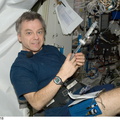
WIKIARCHIVES.SPACE
The Human Spaceflight Archive

Hummocks and blocks on the ejecta blanket of Tsiolkovskiy crater. Image width is 830 meters.
Information
- Taken in
- Author
- NASA/GSFC/Arizona State University
- Description
-
Hummocks and blocks on the ejecta blanket of Tsiolkovskiy crater. Image width is 830 meters.
The farside crater Tsiolkovskiy is one of the most spectacular and unique geologic features on the Moon. A prime candidate for one of the later Apollo flights, Tsiolkovskiy is now one of the highest-priority sites for future human lunar exploration. Identified in the first image of the farside, and named after visionary space pioneer Konstantin Tsiolkovskiy, Tsiolkovskiy (185 km diameter) has a an irregular (non-circular) shape, a central peak, and is incompletely filled with mare basalt.
NASA's Goddard Space Flight Center built and manages the mission for the Exploration Systems Mission Directorate at NASA Headquarters in Washington. The Lunar Reconnaissance Orbiter Camera was designed to acquire data for landing site certification and to conduct polar illumination studies and global mapping. Operated by Arizona State University, the LROC facility is part of the School of Earth and Space Exploration (SESE). LROC consists of a pair of narrow-angle cameras (NAC) and a single wide-angle camera (WAC). The mission is expected to return over 70 terabytes of image data.
- Created on
- Tuesday 4 August 2009
- Albums
- US SPACE PROGRAM / PROBES / MOON / LRO/LCROSS / Mission Photos (Edited)
- Source link
- https://photojournal.jpl.nasa.gov
- Visits
- 20
- Rating score
- no rate
- Rate this photo
- License
- Public Domain
- Modified by WikiArchives
- No (original)
- Downloads
- 1
Powered by Piwigo



